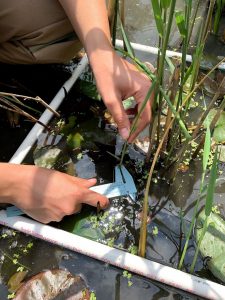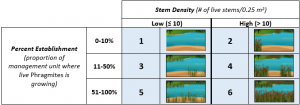July 23, 2019 – Maryellen Zbrozek, USGS Student Contractor
How does PAMF’s model use participant-collected data?
With the end of PAMF’s second full cycle quickly approaching, PAMF participants have been gearing up to collect and submit their data packages. Before asking for those data, we thought we would share a bit about how those data are being used to increase management effectiveness and efficiency.
PAMF systematically learns from Phragmites management across the Great Lakes basin through a computer-based model, which forms the foundation for how PAMF can provide site-specific management guidance to participants. Each year, the model digests incoming data by comparing predicted and observed outcomes, thus becoming “smarter” with each cycle (see Decision Support blog post). But how are participant data actually used in this process?
The model needs three categories of data in order to run: monitoring data, management data, and cost data. These data are retrieved from the monitoring and management reports that participants submit to PAMF each year.
Monitoring Data
When monitoring a management unit (MU), participants collect data about percent establishment, or the proportion of the MU where Phragmites is established, as well as stem diameter and count, which is a measure of Phragmites density in the MU (Figure 1). The model uses these metrics to characterize the invasion status of an MU. The invasion status is categorized into one of six states, ranging from sites with low percent establishment and low stem density to sites with high percent establishment and high stem density (Figure 2). As participants submit monitoring reports over time, the model tracks how the invasion status changes on an annual basis (as it hopefully improves!). Without the data participants submit during monitoring, PAMF would not have any information about the changes that occur on a site-by-site basis.

Figure 1: PAMF’s standardized monitoring protocol includes measuring Phragmites’ stem diameter (as shown) and counting the number of stems within a 0.25 m2 quadrat.

Figure 2: The six states used in PAMF’s model, ranging from low percent establishment and low stem density, to high percent establishment and high stem density.
Management Data
Data about management actions implemented within an MU to control Phragmites are reported for each phase of the plant’s biological cycle: translocating, dormant, and growing (see Phragmites’ Annual Cycle blog post). Management reports work in conjunction with the monitoring reports to teach the model which management combinations work best for transitioning to the lowest invasion state. PAMF’s model focuses on 16 different management combinations used by land managers, each consisting of three management actions used per year (see Management Combinations blog post; Figure 3). By reporting data about which management actions were taken, participants contribute to the pool of data on which management combinations work best in site-specific scenarios. Since the model only accounts for 16 management combinations, it only functions when participants use one of these combinations. When participants report the outcome of applying the management combination they receive as guidance or applying one of the other management combinations PAMF tracks, the model is able to learn more quickly and provide better outputs to participants.

Figure 3: One of PAMF’s 16 management combinations.
Cost Data
Submitting information about the costs associated with each management action is optional. However, we highly encourage participants to submit cost data whenever possible because the model uses these data to derive guidance that optimally balances efficacy against cost. Currently, the model assumes that more labor-intensive management actions are costlier. Although this is a good place to start, our goal is to base the optimization on costs that participants are incurring out in the field. When participants provide cost data, they help the optimization reflect the actual costs incurred by a management action. This allows PAMF to provide participants with guidance suggestions that become more data-driven over time.
Final Thoughts
PAMF relies on this computer-based model to learn from what managers across the Great Lakes basin are doing to manage Phragmites. In turn, the model relies on participants to collect the data necessary for it to run. Without the important citizen-science that participants conduct, PAMF would not be possible and this basin-wide learning would stop! If you are a PAMF participant, make sure all your sites are enrolled and monitored and your management reports are submitted by August 1 so that you can receive the model-provided guidance released in mid-August.
